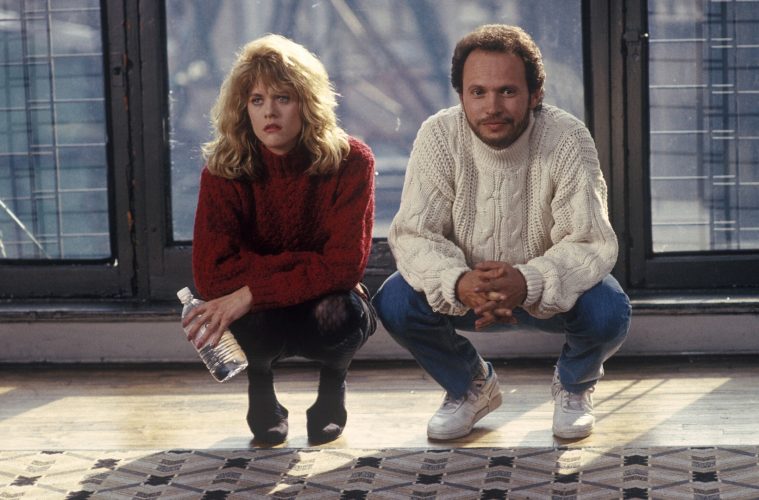I was first introduced to When Harry Met Sally when I was nine years old. I always knew that it was my mother’s favorite movie, but it existed as a sort of enigma to me—I didn’t know anything about the film, and every time I asked about it, I was told that I wouldn’t get it or that it wasn’t for kids or that we’d watch it someday, but not today. I always knew that the movie was important to her, for some reason. Finally, after much nagging on a rainy Saturday afternoon, she relented and we watched it together. That afternoon—snuggled up with my mother on an overstuffed couch, eating popcorn, and watching a movie that I didn’t quite understand—has always stayed with me as one of my favorite memories.
At 23, I now understand why my mother so closely guarded the movie: It was her favorite exploration of love, of lust, of longing that had ever existed on the big screen. She also looked just like Meg Ryan’s Sally to me—the blond hair, the light eyes, the gorgeous outfits. She was also just as staunch in her beliefs and just as particular and high-maintenance and loveable and well-meaning. My mother used to murmur life lessons to me at points throughout the movie: “Don’t let a man treat you like that,” “Never settle,” or—my personal favorite—“Don’t run in the street, ever.” My mother defined what romantic love was for herself, in part, through her experiences watching the film. My mother’s lessons about what to expect, what to hope for, what to turn down, came in part from Meg Ryan and Billy Crystal.
While this may seem foolish at first, we all learn about love—in one way or another—from the silver screen. When I was young, I adored Pride and Prejudice (the Keira Knightley version, of course). I loved the period costumes and the accents, but above all, I coveted the dramatic outpouring of love and emotion, particularly in the rain. I wanted someone to pour their heart out to me and express their undying love, to show me that I owned a piece of their heart, just like the brooding Mr. Darcy does for Elizabeth Bennett. I realized that I, too, wanted someone to accept me for my strong personality and offer me an all-consuming love. I was 12; I had high standards.
As I got older, new movies took Pride and Prejudice’s place. Notting Hill, You’ve Got Mail, and Pretty Woman each came into my life during my early teens and made me wistful for a time that I’d never even experienced—cliché, I know. I wanted to move to the big city and fall in love during autumn wearing a chunky wool sweater. Each new movie taught me a new version of what “real love” was; it was patient, comfortable, warm. I felt like I was learning what I deserved—what I should be searching for—while I watched Hugh Grant from my dorm room.
Movies that weren’t meant to be strictly about love taught me about love. Bridget Jones’s Diary, while exceptionally funny, is really about celebrating being entirely, wholeheartedly yourself. It’s an exploration of the good that comes from vulnerability. I loved Bridget for her flaws from the moment she came on-screen, and in turn started the (long) journey of learning to love myself for my own. More recently, How to Be Single taught me that self-love isn’t just face masks or podcasts, but being able to be happy being alone in a world where the social commodity is being busy and surrounded by others.
It turns out that for the majority of my life, I’ve looked to the big screen to define love for me—a bit ironic for a girl who so staunchly insisted on forging her own path. I’ve searched the screen for years to find the way to capture this magic for myself. I’ve taken lessons or snippets from each film I’ve so ravenously consumed: Pride and Prejudice taught me that what I desire most is passion, When Harry Met Sally taught me that love is feeling so comfortable with someone that you’re empowered to be your true self without fear, and Crazy Stupid Love taught me—clichés aside—that love is complicated and messy. I’ve absorbed lessons about staying true to yourself despite what society tells you, about the kind of men I should be dating (Hugh Grant in Notting Hill) versus the kind I should be avoiding (Hugh Grant in Bridget Jones’s Diary). Mostly, these films have taught me that there are so many iterations of love that it can only be defined by the people in the relationship itself. That it’s sacred. That it belongs solely to the two of you.
Maybe the real magic was that these movies made me hopeful that there is real, enduring love out there in the world for everyone. That the magic is within us all. Maybe the magic is that love looks like all sorts of things to all sorts of people. To some, it looks like Judd Nelson putting in Claire’s earring in The Breakfast Club; to some of us, it’s Hugh Grant being given the original of his favorite painting in Notting Hill; and to some of us, it’s having that person who will spend their weekend building you a desk so that you can write this piece. There’s magic all around us, and this Valentine’s Day, I’m grateful for the movies that taught me that all I need to do is be myself and look for it.

